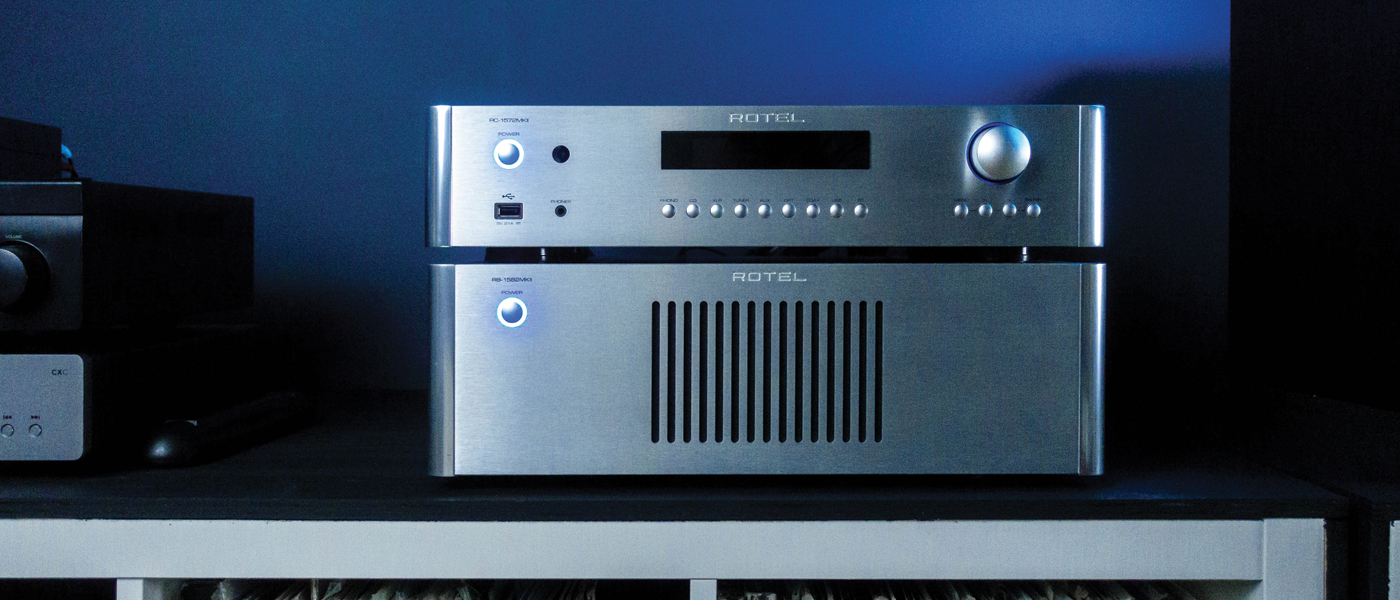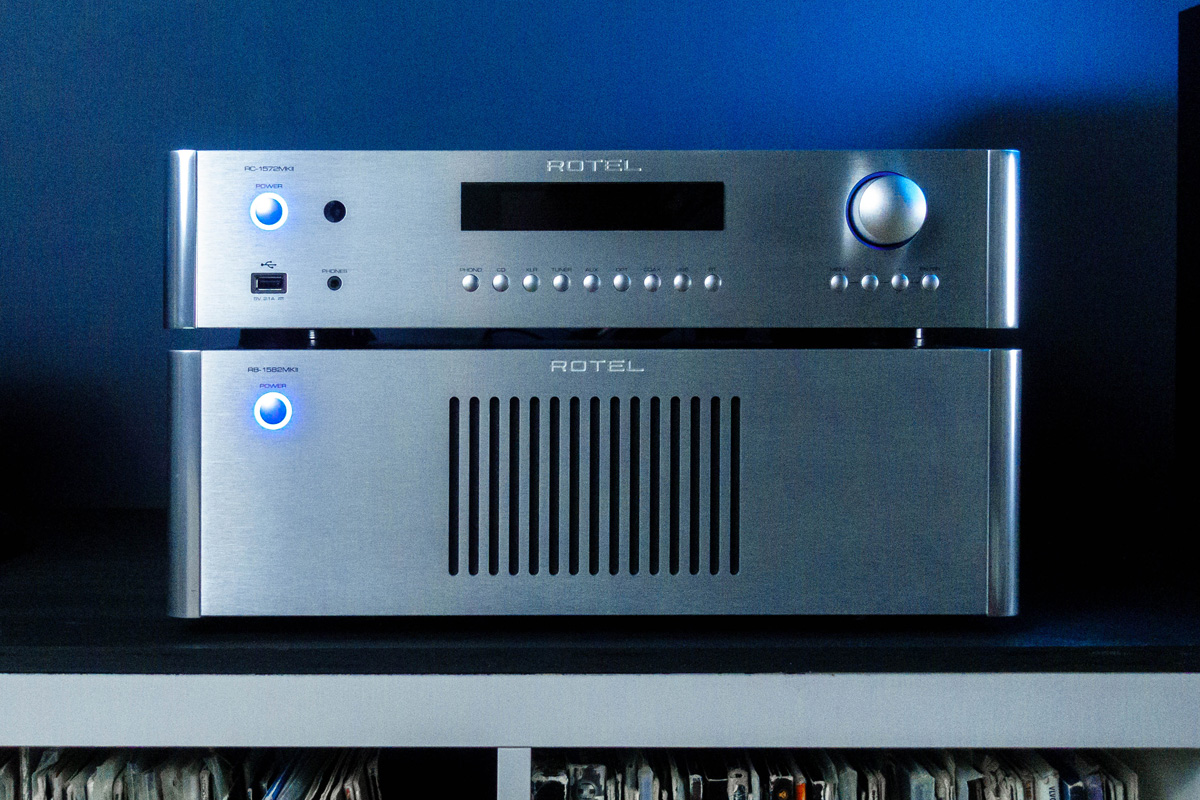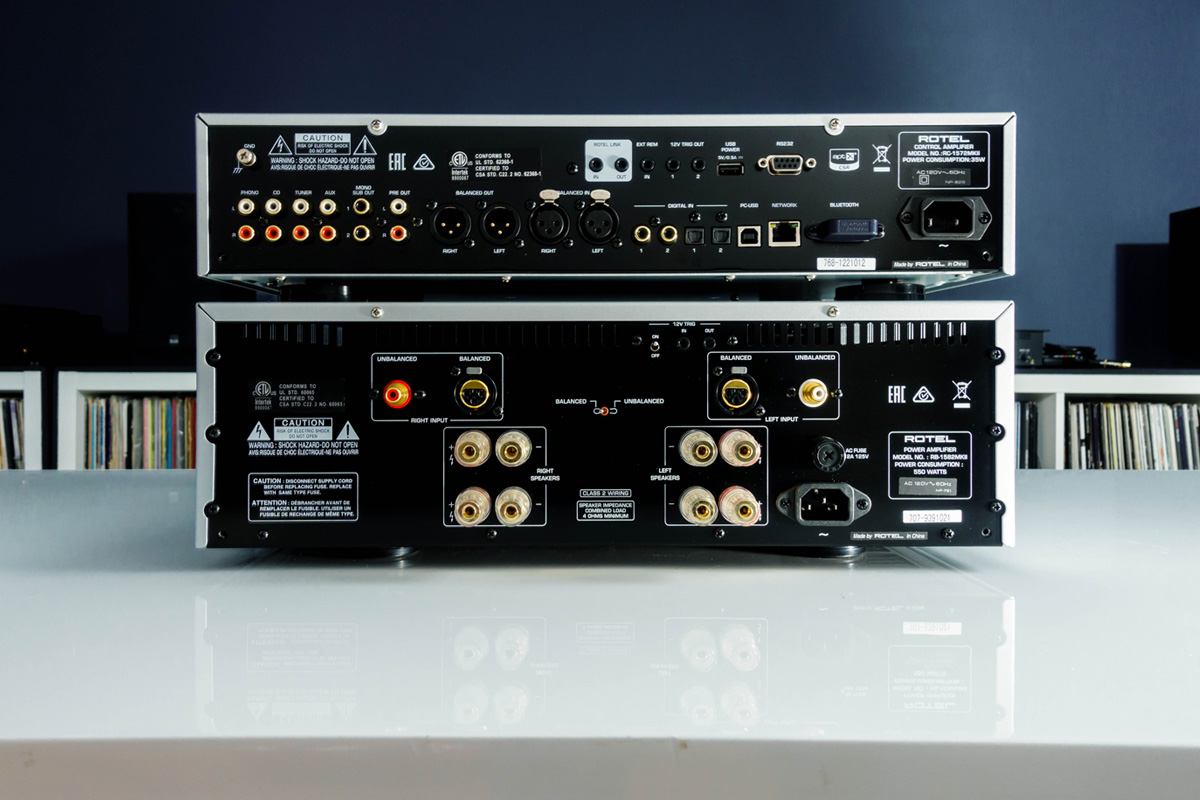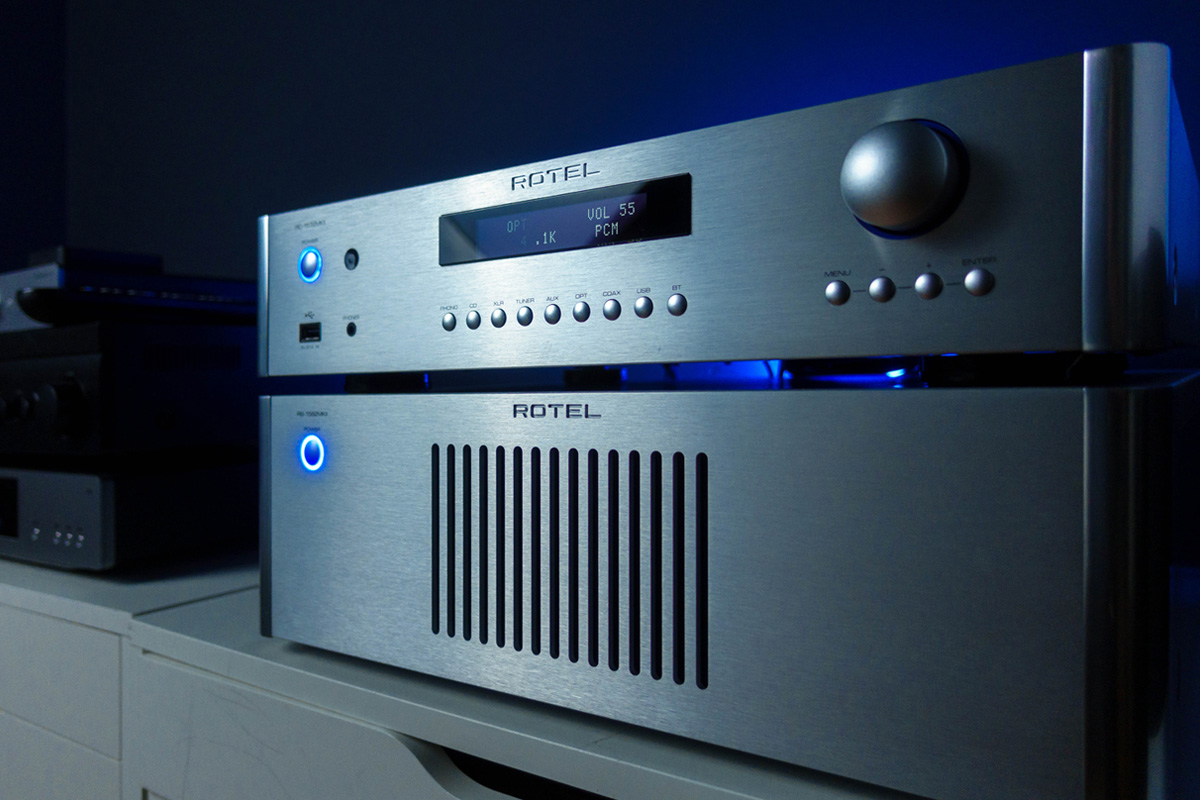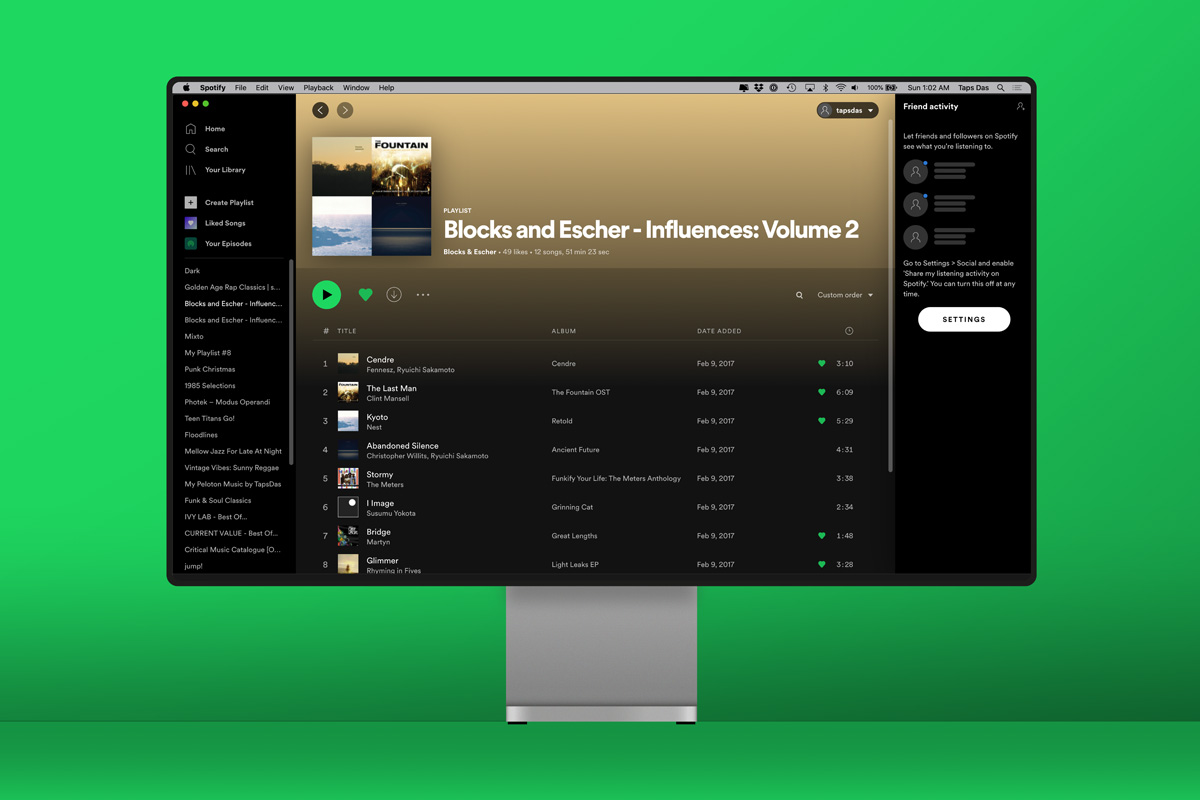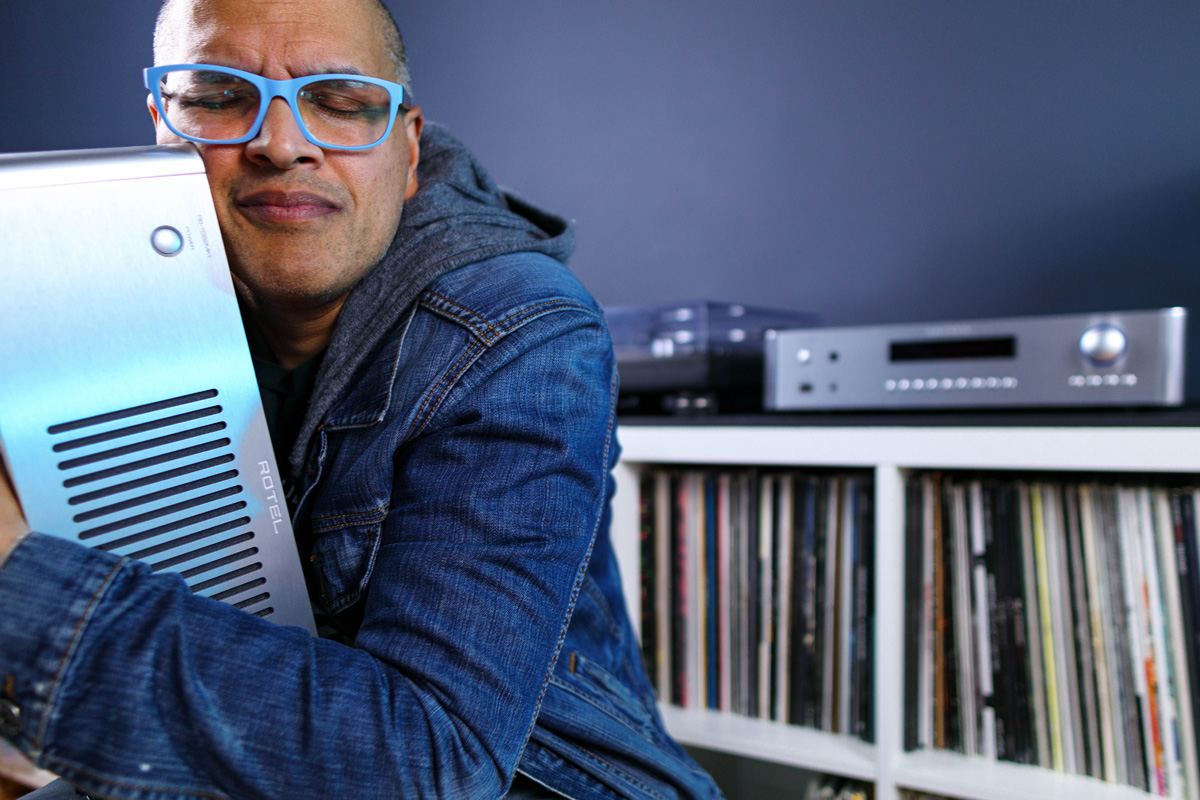And it happened. I fell in love once again with a sweet review setup (this tends to happen a lot). This time it was Rotel’s dynamic duo of the RC-1572MKII Stereo Preamplifier and the RB-1582MKII Power Amplifier. I’ve had a long-standing lust for the RB-1582MKII (it was even a wallpaper for my Macbook Pro for a bit before being replaced by the Kia Stinger GT, sigh…) and Rotel came through with a wish come true. The moral of this story is to ask, and you shall receive. I asked and luckily, Home Theater HiFi has some great connections to make it happen.
Rotel RC-1572MKII Stereo Preamplifier and RB-1582MKII Power Amplifier
- Moving magnet phono input
- Upgraded internals
- Inputs can be fixed and variable
- Wireless aptX & AAC Bluetooth
- Certified Roon tested
- Supports MQA and MQA Studio
- 32-bit/384kHZ DAC
- 200-Watts Class AB (8 Ohms)
- Balanced XLR inputs
I don’t personally own separates. Not because they’re not good, but for me, they’re cost-prohibitive, and not easy to justify over an integrated amp that can do just about everything a two-box setup can. Still, there’s the whole flexibility of having separate components and the ability to switch out components at a whim. Having individual boxes that each perform a single task can also help mitigate heating issues. Not to mention that 200 watts of Class AB power isn’t something you typically find on integrated amplifiers which also opens the doors to a wider range of speaker options. Yeah. You know, good HiFi reasons.
Once I took delivery, I quickly shot a quick unboxing of the components which you can view here.
I decided to set the Rotel duo up in two areas. The first was in the living room, paired with a Cambridge CXN V2 Streamer. The second was my basement studio, paired with a DJ setup, CD player, and a few other fun pieces.
RC-1572MKII STEREO PREAMPLIFIER
Total Harmonic Distortion (20Hz-20kHz):
< 0.004%
Intermodulation Distortion (60Hz : 7kHz, 4:1):
< 0.004%
Input Sensitivity / Impedance:
Phono Input (MM): 3mV / 47k ohms
Line Level Inputs (RCA): 200mV / 100k ohms
Line Level Inputs (XLR): 300mV / 100k ohms
Output Level:
Line Level (RCA): 1V
Balance (XLR): 2V
Frequency Response:
Phono Input: 20Hz-20kHz (+0.3dB, -0.2dB)
Line Level Inputs (RCA): 10Hz-100kHz (+0 dB, -0.2dB)
Line Level Inputs (XLR): 10Hz-100kHz (+0 dB, -0.2dB)
Tone Controls:
Bass: ±10dB at 100Hz
Treble: ±10dB at 10kHz
Signal to Noise Ratio (IHF “A” weighted):
Phono Input: 80dB
Line Level Inputs (RCA): 118dB
Line Level Inputs (XLR): 118dB
Channel Separation:
Phono Input: > 85dB
Line Level Inputs (RCA): > 85dB
Line Level Inputs (XLR): > 75dB
DIGITAL SECTION
Frequency Response:
20Hz-20kHz (± 0.5dB, Max)
Signal to Noise Ratio (IHF “A” weighted):
100dB
Input Sensitivity/Impedance:
0dBFs / 75 ohms
Preamplifier Output Level:
1.44V (@ -20dB)
Coaxial/Optical Digital Signals:
SPDIF LPCM (up to 24-bit / 192kHz)
PC-USB:
USB Audio Class 1.0 (up to 24-bit / 96kHz)
USB Audio Class 2.0 (up to 32-bit / 384kHz)*
*Driver installation required
MQA and MQA Studio (up to 24-bit / 384kHz)
Roon Tested
Power Consumption:
35 watts (<0.5 watts in standby)
Dimensions (W x H x D):
431 x 99 x 338mm (17 x 3 7/8 x 13 1/4in)
Weight (net):
8.4kg, 18.5lbs
Finish:
Silver or Black
MSRP:
$1,399.99
RB-1582MKII POWER AMPLIFIER
Continuous Power Output (20-20kHz, < 0.03%, 8 ohms):
200 watts per channel
Total Harmonic Distortion (20Hz-20kHz, 8 ohms):
< 0.03%
Intermodulation Distortion (60Hz : 7kHz, 4:1):
< 0.03%
Frequency Response (μ0.5dB):
10Hz-100kHz
Damping Factor (20-20,000Hz, 8 ohms):
800
Speaker Impedance:
4 ohms minimum
Signal to Noise Ratio (IHF A network):
116dB
Input Impedance / Sensitivity:
Unbalanced: 12 kOhms / 1.9 volt
Balanced: 100 kOhms / 3.0 volt
Gain:
Unbalanced: 26.5dB
Balanced: 22.5dB
Power Consumption:
550 Watts
Dimensions (WxHxD):
431 x 144 x 407mm, (17 x 57/8 x 16 in)
Weight (net):
17.6kg / 38.80lbs
MSRP:
$1,899.99
Website:
Company:
SECRETS Tags:
Rotel, rb-1572mkii, rc-1582mkii, preamplifier, power amplifier, stereo, separates, Amplifier Review 2022
- Rotel A14MKII Integrated Amplifier Review
- Rotel RC-1590 MkII Stereo Preamplifier and RB 1590 Stereo Amplifier Review
This combo is pretty big and chunky. In photos, the RB-1582MkII appears to be clean, sleek, and minimal. In person, the chunkiness sort of takes over. Much like the A14MKII, the build is solid and sturdy but also a bit classic modern rather than modern-modern. The front fascia is a nicely brushed aluminum with 15 thin vertical slats serving as a front grill. Above the grill is a machined Rotel logo. At the top left is a small power button. The front corners are shiny rounded metal. The sides are finished in matte grey metal. I think the shiny metal corners are what throws off the design for me. If the front fascia extended to the corners and were a bit sharper, I think it would look cleaner. The power button makes a meaty and satisfying click. When turned on, a bright blue ring of light appears that if I’m being honest cheapens the look a bit. Now, I’ll admit to being biased against bright LED lights on HiFi gear. But if the light ring were white instead or at least dimmable it would make the RB-1582MKII much classier in appearance. Rotel, to their credit, has included some “Power Button Masking Ring” stickers which you can affix to mitigate some of the brightness. I so wanted to but since I have to send these units back, I decided against it. Around the back are a set each of balanced and unbalanced connections, a switch to toggle between them, two sets of speaker outputs, and trigger connections. Included in the box are heavy rack frames for, you guessed it, rack mounting. I left them in the box as this bad boy will be sitting pretty on a shelf.
The RB-1582MKII delivers a beefy 200-watts per channel at 8 ohms. Stealing the verbiage right from Rotel’s marketing material; “The RB-1582MKII’s high-end performance begins with an extremely large toroidal transformer combined with a total of 60,000uF storage capacity in special “slit foil” capacitors to provide completely stable power to the output stage. Slit foil capacitors have the ability to charge and discharge extremely quickly, thereby ensuring signal fidelity during orchestral crescendos or repetitive kick-drum impacts, for example. Both left and right channel construction are laid out in a mono-block design (after the toroidal transformer) and all grounding is terminated in a star pattern on a copper grounding plate to ensure low signal to noise. The output stage is a discrete design that consists of 10 high current bipolar transistors per channel. Input options consist of both balanced XLR and unbalanced RCA connectors.”
The Preamplifier follows suit design-wise. The chassis is essentially the same but shorter in height. The RC-1572MKII is the smaller sibling to the reference level RC-1590MKII Preamplifier. Rotel made extensive performance upgrades to their 14 and 15 series integrated amplifiers and now has made similar upgrades to their preamplifiers as well. Specifically, over 75 critical component changes, enhanced acoustic circuits that borrow technologies from the Michi Series.
The front panel starts on the left with a power button, below that, a USB input for smartphones, then an IR sensor, and a 3.5mm headphone output. In the center is the same, machined Rotel logo with a thin LED screen below it followed by nine small, round source selector buttons. On the right side, is a medium-sized volumed knob with four rounded buttons below for menu control. The back shows off the ample connectivity. From the left, a phono input with the ground, three RCA inputs, two mono sub outs, RCA pre-out, balanced pre-out, balanced in, four digital inputs (two coaxial and two optical), a PC USB, a Network input, and a Bluetooth module. Above on the right are trigger outputs, a USB power output (not for playing music), and an RS-232 port. The DAC is a Texas Instruments premium 32-bit/384kHz chip that is Roon tested, supports MQA and MQA Studio via a PC USB input, and features wireless aptX and AAC Bluetooth. If somehow you need more connectivity, then you might be a hoarder.
The powered USB input on the back of the RC-1572MKII is used to power smartphones and the like, but honestly, I used it to charge the batteries for my RX100 VA camera. It’s so convenient!
Once switched on, the units can be put into standby with the remote when tethered by a trigger cable so that both units turn on together. The LED on the RC-1572MKII is an old-school, white-on-black, text-based screen. Like the A14MKII, the RC-1572MKII takes a bit of menu diving to get up and running. The power button is dimmable, thankfully and I made sure to do so. However, I must admit that it makes the overall package look a bit odd as I can’t dim the LED on the RB-1582MKII power amplifier. But again, the included stickers would make this a non-issue.
My associated equipment was:
- Cambridge CXC CD transport connected via optical
- Cambridge CXN Streamer via analog RCA and optical
- Cambridge DacMagic 200m connected via RCA
- Two Technics 1210MKII’s sporting Shure DJ cartridges via a Pioneer DJM450 connected with 1/4-inch cables
- NAD 326bee integrated amp acting as a preamp
Speakers:
- B&W 685 S1 Bookshelf speakers
- Monitor Audio RX2 Bookshelf speakers
- Q Acoustics 3030i Bookshelf speakers
Subwoofers:
- B&W 610
- Q Acoustics QB12
I connected the RC-1572MKII and RB-1582MKII with balanced cables.
I’m going to get this out of the way from the jump. I need to get some better speakers. I love my B&W’s but they’re pretty much entry-level and starting to show their age after about 12 years of use. I find them to image better overall than the Q Acoustics 3030i but they’re about even when it comes to bass weight. The RX2s were a great match for the Rotel to my ears but I ended up selling them to a friend as he fell in love with their sound when I loaned them to him.
With my current gear, I don’t NEED an upgrade but, as I’ve gotten the chance to review some great amplifiers for Secrets, I’ve become a bit spoiled after hearing the next-level-up in sound. The next level of ‘Oomph’ is quite palpable, and the extra detail and clarity are addictive. Once you hear it, it’s tough to go back. With the power available from the Rotel RB-1582MKII, I would no doubt appreciate a speaker upgrade and have started going down the road of picking out some favorites. Of note, my wish (lust) list includes the upgraded Monitor Audio Silver 100 7G, Elac Unifi Reference, Wharfdale Linton, The Kef R3, B&W 706 s2, and the Buchardt S400 MKII. If I have my way, I’ll be shelling out to own more than one of these pairs in the next year.
I took delivery of the Rotel pair before the Holidays and enjoyed them for an extended period, longer than I imagine most reviewers get a chance to (sorry Rotel!). Break-in took a few days; I didn’t keep track of the total hours, but I took my time listening to podcasts and low-volume music. And yes, I absolutely had to try it: Swapping out my NAD 326bee for preamp duties. Not so much for review purposes, but ‘personal-decision-making’ purposes. I’ve been looking at the RB-1582MKII for so long and the thought of sending it back brought me great pain so if there was a feasible route to keep it around while not incurring too much debt, I’m going to explore it. The supplied remote for the RC-1572MKII is par for the course for Rotel. It’s a basic-looking black wand with all black buttons save for one red button in the top left corner which is for turning the unit off. I would have thought that the only colored button on the remote would be earmarked for turning the units on instead. In all, the remote’s functions are very comprehensive and designed for an all-Rotel system. It’s pretty simple to dive through the RC-1572MKII’s menus from the remote itself.
Moving on, my favorite pairing was with the B&W 685s (surprise, surprise), after selling off the RX2s. Both speakers matched very well to my ears with the RX2s being a bit brighter (partly due to the metal driver). The Q Acoustics 3030i while nice, is a bit warmer and rolls off the top a bit more than the other two.
I do wish the RC-1572MKII featured some sort of built-in bass management. For those of you that run bookshelf speakers as I do in my studio, I would love to set a cut-off so that I can be a bit more loosey-goosey with the volume and not worry about the integrity of the speaker’s woofers as I turn up the volume. The RX2 with its larger 8-inch woofer handled the power output better and took to the power increase with ease. But the B&W ended up being my favorite as I prefer its overall sound better.
Functionality-wise once I dialed in my settings per speaker.
- B&W 685 (Bass +2, Treble +1)
- Monitor Audio RX2 (Bass +1, Treble 0)
- Q Acoustics 3030i (Bass +1, Treble +2)
After dialing in the tone settings, I found no need to return to the menu for any reason. Every function I needed to adjust was accessible from the remote. In that sense, this pairing is super easy to live with for normal use. During low volume listening—which I did quite a bit of—the dialogue in music is clear with the low end seeming recessed. Cranking up the volume knob and bringing the dB level to about 68, the sound comes alive. The bass levels up to match the mids and the highs scale nicely.
Then… I hit a bit of a snag. Playing music via Bluetooth or USB, the audio would play for about five seconds and then cut out. No matter what I did, switched cables nothing would work. So, I reached out to Rotel to see what was going on. They said that there was a ‘Crucial Firmware Update’ that needed to be installed, for the preamplifier to function properly. The catch? You need a PC to install it. I’m a Mac guy, and to be honest, I don’t know any PC users. But the folks at Kevro (Rotel’s distributor in Canada) could make the update for me. So, I took the opportunity to drive over and get the update done in-house. Rick Lennon (shouts to you my friend) from Kevro, was kind enough to sort me out. My reason for heading down was two-fold, Kevro is also the distributor for Monitor Audio and Roksan so I thought I might be able to sneak a listen to the new Silver 7G series and maybe the Roksan Attessa line? (I’m not opposed to begging.)
I show up, Preamp in hand. But with Covid restrictions and the safety of others taking priority, I couldn’t actually venture inside to listen to anything, I had to wait in the car, a bit of a bummer, but I’d rather err on the side of caution. The update ended up taking a bit of time, so Rick offered to drive the unit back once completed. And to his word, he did just that. What a gem, I can’t thank you enough, Rick. Needless to say, the update made a huge difference. USB is now 2.0, and I was able to play music without it stopping. Suffice to say if you were to purchase the RC-1572MKII make sure the unit has already been updated, or you have a PC in your possession, or your local dealer installs the update for you.
Spotify – Blocks and Escher Influences 1&2
Starting this review in my living room, paired with the CXN Streamer. I tried the combo out two ways: First, with the streamer connected to the Preamp and then with the CXN V2 connected directly to the Power Amp in ‘Preamp Mode’. The CXN V2 up-samples everything to 24-bit/384kHz and has two Wolfson WM8740-based DACs. It also features RCA and XLR outputs, so you know I had to use my new XLR cables. I used a playlist on Spotify and found myself going back every so often to Blocks and Escher. This amazing drum and bass duo put together an ‘Influences Playlist’ of what I assume are tracks that influence their own wonderful music. There’s a lot of variety here, but all the selected tracks have very cinematic qualities to them. One of my favs, ‘Stormy’ by the Meters, has a bit of everything. Head nodding vibes, atmosphere, thick bass, and that bit of darkness. I switched between the Monitor Audio RX2s and B&W 685s for this portion. The difference between having the CXN connected directly vs through the RC-1572MKII is subtle, to say the least. There’s a tad more weight to the sound when the signal is sent through RC-1572MKII. I admit to not being overly confident in my assessment and could be convinced that I’m splitting hairs. I did notice that I was listening more intently than usual to the subtleties in the music with the Rotel duo. Whether that was due to the clarity and detail retrieval of the setup is something I would have to pay attention to going forward.
Moving downstairs to my studio is where I was most excited to try out some other combos. I like to create my own music and recently have been making some Hip-Hop beats at 85 bpm as well as a few mellow D&B tunes. I always test out the mixdowns on the many systems throughout my home and the crappy stereo in my car to get a sense of how they sound as my studio setup is not yet sound treated. Then the final mix is done using headphones. Having a killer system in for review is all the more reason to get moving on finishing some tunes. When I’ve finished a mix, I bounce it and put that version onto my desktop, iPhone, and then a thumb drive.
My newest tune, Fall Water can be heard on my Soundcloud.
Playing a newly polished mix through the Rotel combo is a treat that I can’t quite quantify. It’s just awesome. For the most part, playing from an iPhone via Bluetooth was the easiest way to hear my song quickly. But I also made sure to stream from my Macbook via the USB, using a USB-C dongle. Hearing any flaws in the mix wasn’t as easy as I expected. The Rotel combo is that smooth. I could spend most of this review talking about the sheer grunt and power of the RB-1582MKII, but when paired with the RC-1572MKII the presentation is very smooth. There’s plenty of ‘Oomph’, but it’s almost like a linebacker who could charm the pants off you. Everything sounds great no matter how I connected equipment and no matter what type of music I sent through it. I tried bypassing the tone controls to see if it made a marked difference at all. Nope. This is not a combo that will analytically pull apart your music and lay bare the intricacies of a mix. It may not be best for critiquing my mixdowns but, it is awesome for casual listening.
I decided to switch out the RC-1572MKII, with my NAD 326bee—which cost a heck-of-a-lot less—using the pre-outs from the NAD, connected to the RCA inputs of the RB-1582MKII. I also connected the Cambridge DacMagic 200M to the NAD to stream my music through. To my ears, the NAD 326bee sounded a bit brasher in comparison to what I was hearing from the Rotel RC-1572MKII. If you saw my DacMagic 200M review you know that I found it to be rather neutral in tone. Running my track ‘Fall Water’ back once more, I was able to hear it. That ‘it’, is a slightly more clinical and dry presentation, which made it easier to hear sounds that needed to be tweaked. There was also some audible noise in empty passages that wasn’t there with the RC-1572MKII. If I were a betting man, I would say that most will prefer the full Rotel combo over what I’m trying out. I also tried the DacMagic 200M connected directly to the RB-1582MKII in preamp mode. Yep, that’s possible! There’s no remote for the DacMagic, so you would have to get up whenever you wanted to change the volume, but it does work, and the neutral tonality of the DacMagic sounded good. It was dry and less smooth than the Rotel RC-1572MKII. Also, it doesn’t have tone controls, so that combo would be a deal-breaker for me.
Back with the RC-1572MKII taking on preamp duties, it was time for some vinyl. I tried out the built-in phono stage for a bit, but admittedly, I prefer using a DJM450 mixer over a phono stage. Yes, the built-in phono stage is better sounding than whatever Pioneer has crammed into its mixer. It’s less shrill sounding overall. But for me, I don’t listen to vinyl for HiFi. I love mixing. And will trade off sound quality for fun every single time.
Broken – Blocks and Escher (Paradox Remix)
Dev Paradox (Aka Alaska) has a deep catalog of music. And I own a fair bit of it. Mostly on vinyl. And I would be lying if I said I didn’t reach for some of them for this review. Paradox’s remix of Blocks and Escher‘s Broken is just… all the feels. The second drop (into drums that I can’t even begin to understand how to replicate), just kills. Every single time. Enough that my wife had to run down to my studio and beg me to turn it down on more than one occasion. The solid bass and intricacies of the drums are a great match for the Rotel. The power reserve smoothness of the Rotel pairing shows no sign of strain with the volume turned up. The only thing that keeps me from being too generous is my speakers.
Turning to CDs, I haven’t bought a CD in forever, so I’m left with whatever we have on hand. A familiar favorite is The Cinematic Orchestra’s Ma Fleur. It’s all well presented with good balance, lots of separation, and my gosh, bags of oomph! I never once came close to max volume with this combo. I mention this, as turning up the volume didn’t bring out any strain or distortion to the sound. It just got louder. It was quite like the McIntosh duo I reviewed a while back. I’m steadily gaining an appreciation for the extra headroom that a high-powered amplifier has to offer.
The ROTEL RC-1572MKII PREAMPLIFIER AND RB-1582MKII POWER AMPLIFIER deliver plenty of clean power, rich dynamics, and attractive styling at a price lower than that of many high-end separates.
- Lots of clean sound.
- Rich and smooth dynamics.
- Tons of connectivity.
- Dimmable power button on RB-1582MKII.
- Easier firmware update procedure.
Suffice to say I’m a fan. The RC-1572MKII Preamplifier has more connectivity than I will ever need, which makes it flexible should you, later on, add it to your system. Couple that with 200 watts of Class AB power? I’m all set. Full disclosure, I ALMOST ended up shelling out for the RB-1582MKII Power Amplifier. Not because one piece was better than the other. But purely out of a cost-savings measure. The RC-1572MKII is overkill for me, as I’ll only use two of the inputs regularly. I’m happy to use either the NAD326bee as a preamp or the CXN V2 in preamp mode paired with the power amp for personal use. In the end, it just was not in the cards budget-wise just yet. I need a new car more than anything, so I am actively saving for that before I jump into high-end amplification. But man, I’m sort of regretting that decision as I write this.
This Rotel duo is a big chunk of very capable and flexible HiFi. If you are in the market for separates or looking to upgrade your system, then this package is definitely worth your time or at the very least, an audition. Thanks for reading!



